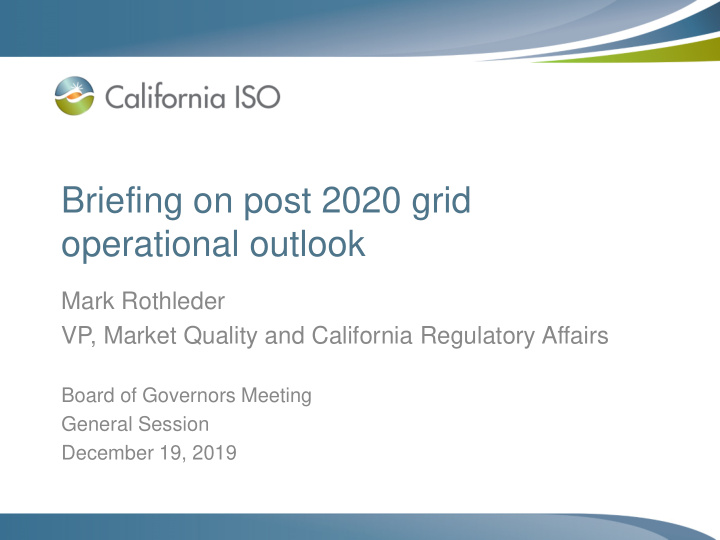



Briefing on post 2020 grid operational outlook Mark Rothleder VP, Market Quality and California Regulatory Affairs Board of Governors Meeting General Session December 19, 2019 Page 1
Challenges • Update on Challenge 1: Capacity shortfall in 2021 and meeting summer evening peak load • Challenge 2: Increased ramping needs • Challenge 3: Low renewable energy production from multi-day weather events Page 2
Challenge 2: Increased ramping needs • Rapid increases in demand or “ramps” are being met by natural gas resources and imported energy – Relying on natural gas resources is counter to low-carbon power grid (Senate Bill 100) – Availability of imports are uncertain • Curtailment of solar resources may be increased to flatten the ramp and avoid operational issues Page 3
Gas and imports respond to meet maximum ramp rate after the sun sets Jan 1, 2019 peak load: 26,997 MW at 6:22 p.m. Max 3-hour ramp: 15,639 MW Starting at 2:25 p.m. Page 4
By 2030, solar is expected to contribute to increasing ramping needs Max 3-hour ramp 2019 actual 15,639 MW 2030 approx. 25,000 MW Max Export and ramping 3-hour ramp Where system limitations trigger 15,500 MW is expected to curtailment actually operate Page 5
Challenge 2: Increased ramping needs – ISO actions • Completed – Expand the ISO’s western markets to maximize solar production with greater geographic diversity – Ensure inverter-based resources ride-through fault events • In progress – Ensure resources are following dispatch instructions – Incent all resources, including renewable resources, to provide dispatch bids, ancillary and other services • Future – Consider ramp constraints on variable resources to ensure they are not ramping up faster than can be accommodated Page 6
Challenge 2: Increased ramping needs – other actions needed • Increase visibility and control of commercial and consumer solar resources Other actions to consider: • Implement dynamic pricing policies that shift load to periods of high solar Long & short duration storage • Diversify the mix of renewable resources to increase output at the right times to Time of Use rates match system needs; e.g. offshore wind Electric vehicle • Ensure resources have low minimum integration operating points or shut down mid-day • Increase regional collaboration to improve flexibility and geographic diversity Page 7
Challenge 3: Low renewable energy production from multi-day weather events • During multi-day cloudy or low wind events, energy from other sources will be needed to meet demand • Storage resources with short durations (~4 hours) might not have an opportunity to recharge during a multi-day event • Multi-day events are hard to forecast in both operational and planning horizon Page 8
Multiple days of low solar production hinders ability of storage to recharge Multiple day low solar production Jan 13 –18, 2019 12,697 MW Installed solar capacity Solar production as a percentage of total installed capacity 90% Solar peak output record (7/2/19) Page 9
Low solar production across multi-day event – high reliance on natural gas and imports Typical solar days Multi-days of low solar Max solar: Max solar: 2,100 MW Multi-day low 8,900 MW solar will hinder short-duration storage ability to recharge Page 10
The Kauai experience – July 21, 2019 • Kauai Island Utility Cooperative – approximately 70 MW of load • Loss of gas generation – 27.5 MW • All hydro resources on maintenance outage – 16 MW • Major storm caused low solar production for multiple days • Solar – Battery storage unable to serve load each day A. 28 MW solar with 100 MW-hr storage (four hours) B. 13 MW solar with 52 MW-hr storage (four hours) • Result: initial outage of two hours, two days rotating outage of 30 min for 3-4 hours in early morning • Restored regular service after offline generation was put into service and solar production was increased Page 11
Challenge 3: Multi-day low renewable production events – other actions needed • Diversify resource mix both technologically and geographically • Develop resource strategy that supports multi-day events: – Develop significant amounts of storage with varying duration – Assess availability of imports – Develop cost-effective alternatives for multi-day and seasonal events; including, demand response, etc. – Reduce use of natural gas resource while strategically maintaining sufficient capacity for reliability • Consider multi-day low production events in resource planning studies Page 12
Recommend
More recommend